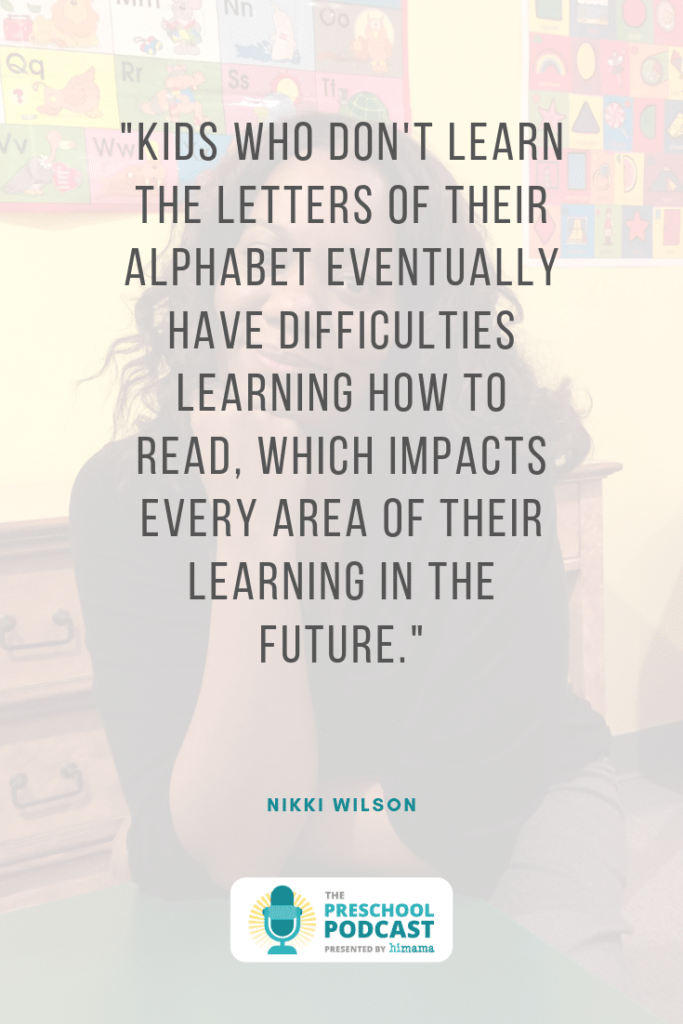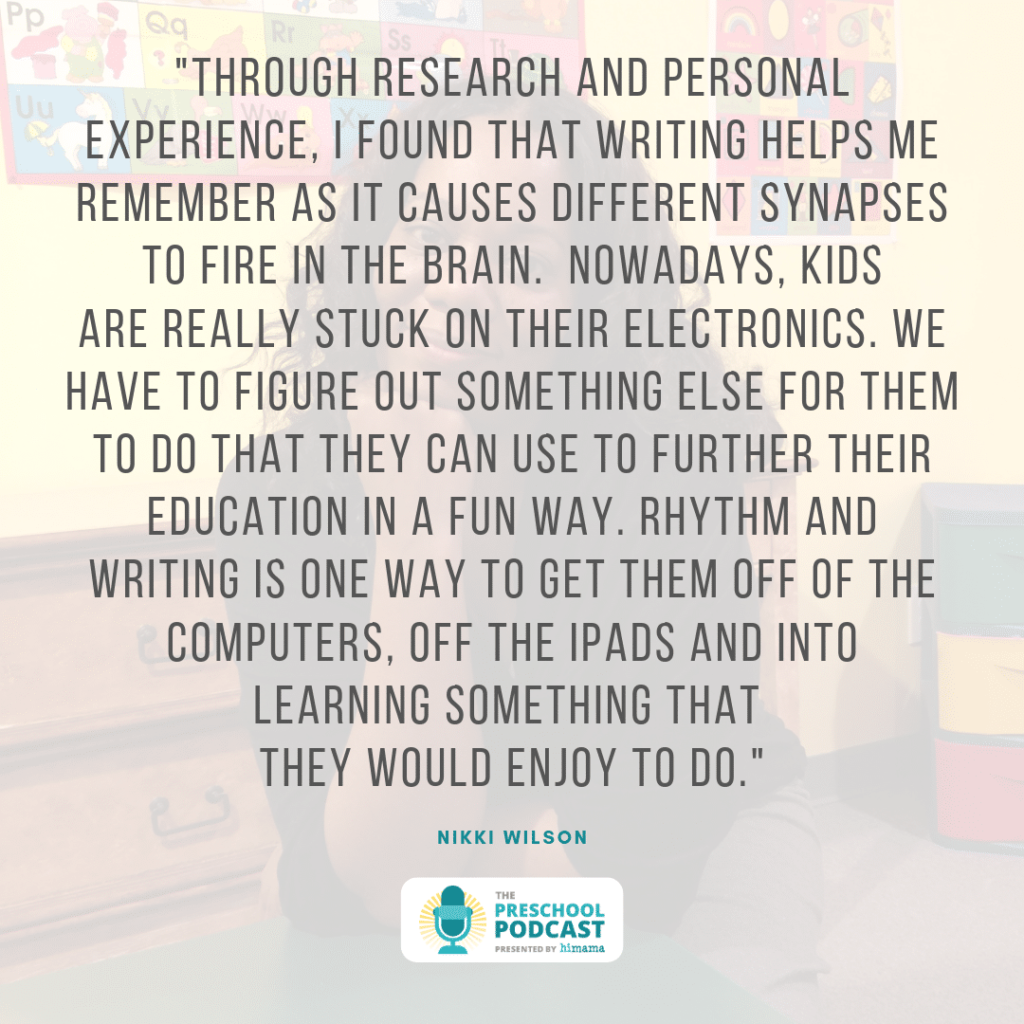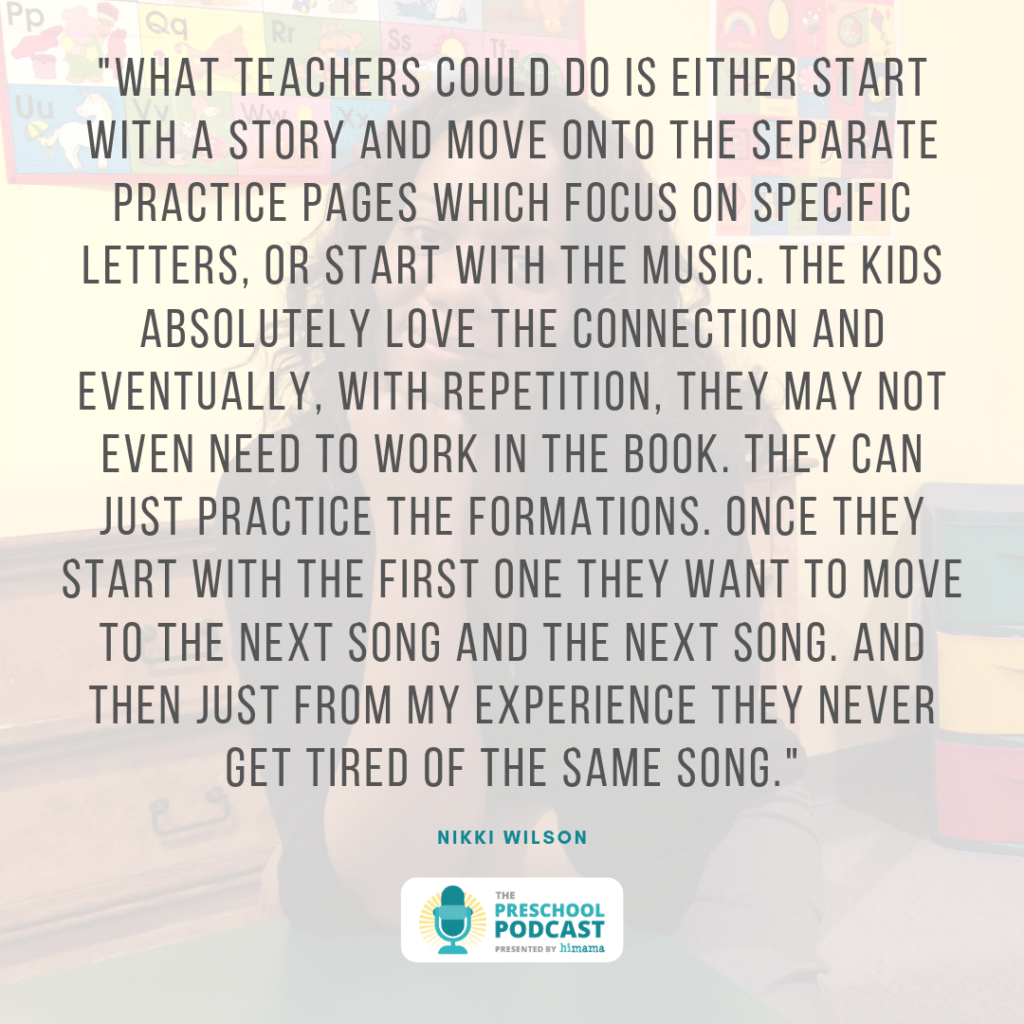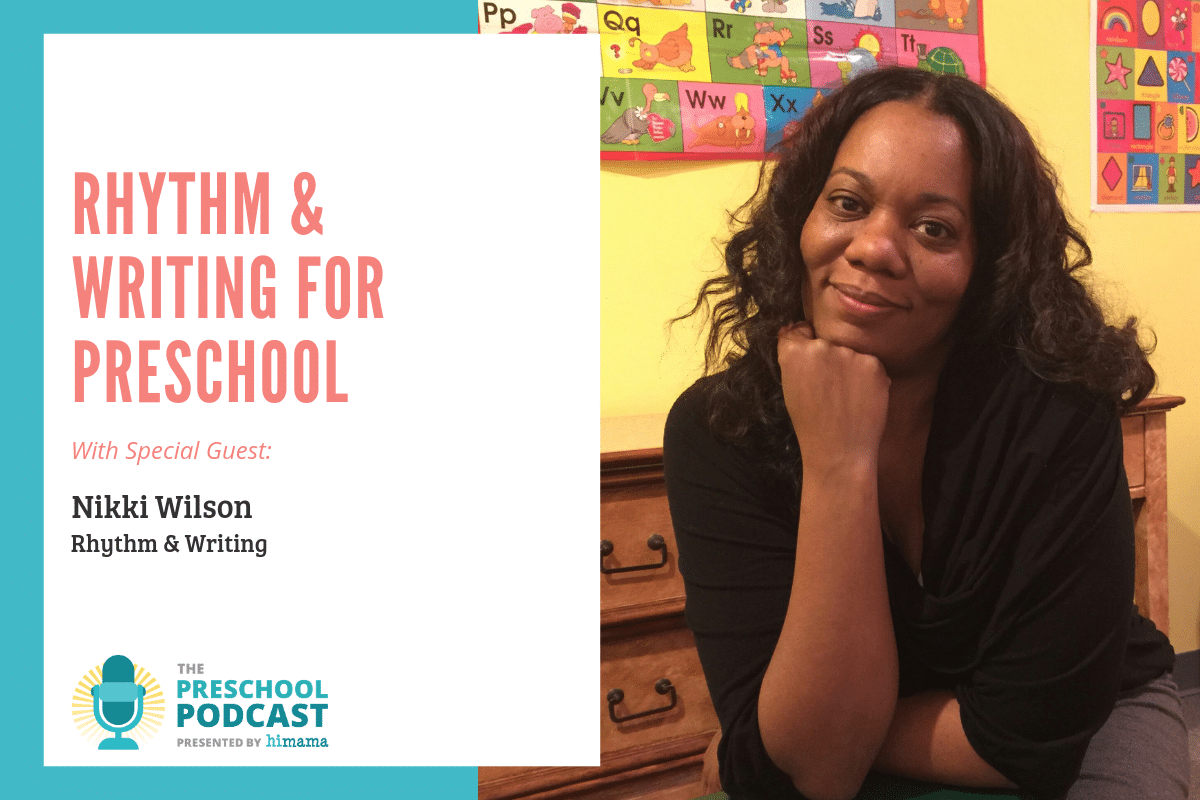Check all episodes of The Preschool Podcast
Episode 147 – Young children learning writing preschool is really important as it combines fine motor and cognitive skills, as well as contributes to literacy as they grow older. In this episode, we have a conversation with Nikki Wilson, creator of the Rhythm and Writing program that supports children in learning how to write by combining hip hop tunes with letter formation. She shares her story and method as well as the importance of making learning fun for the kiddos from an early age!
Resources:
Episode Transcript

Nikki WILSON:
Kids who don’t learn the letters of their alphabet eventually have difficulties learning how to read, which impacts every area of their learning in the future.
Ron SPREEUWENBERG:
Nikki, welcome to the Preschool Podcast!
WILSON:
Thank you. Glad to be here.
SPREEUWENBERG:
We are so lucky today to have on the podcast Nikki Wilson. She’s an occupational therapist and the creator of Rhythm & Writing with the Get Write Crew. We’re going to learn all about it today on the Preschool Podcast. Let’s start off, Nikki, learning a little bit more about you and how you got to where you are today with the creation of Rhythm & Writing.
WILSON:
Okay, well, I’m an occupational therapist. I got my degree from New York University in 2001 after getting my bachelor’s degree from my hometown of Kalamazoo, Michigan at Western Michigan University. And since then I’ve been providing school-based occupational therapy services. And the majority of the kids that I serve have had handwriting difficulties. And no matter what I did, no matter what strategies I tried, the majority of these kids who already had handwriting difficulties just could not understand or remember the correct formations of letters.
And so I just decided to try something new. And what I did is, for every letter I created a rhyme to go with it. And so, like, capital L would be, “Long lines down in a cross.” And lowercase T would be, “Long lines down and across the middle,” and it worked. Our kids would remember the formations. And then while they were practicing writing I would say the formations and then eventually they would remember the formations themselves. And when they were writing their letters they would say the formations and then start to form their letters properly.
And so I was surprised. It was amazing. I was working with primarily kids with special needs and a lot of kids with autism, and the strategy even worked with them. And so as I further developed the program it went from simply just the rhymes to incorporating music into the program. And so that made it even more fun, and it helped the kids remember them easier.
SPREEUWENBERG:
And why do you think children were struggling with that the traditional way of learning how to write?
WILSON:
Well, these days they don’t really spend a lot of time teaching handwriting. And so kids come into school already knowing how to write. And so the formations that they were used were already engrained; they were habits. And so the difficulties that they were experiencing… it’s hard to break a habit, basically. And so that’s why I think it was harder to teach them the proper way and for them to incorporate it into their daily handwriting.
SPREEUWENBERG:
And with the digital world we’re living in, why do you feel it’s still so important for children to know how to properly do handwriting?
WILSON:
Well, just through the research that I’ve gone through for other presentations – and also from my own experience – I found that writing helps me remember. And I know that through handwriting there are also different synapses that are formed in the brain. There are different motor training that is developed. And so it also helps with even further development of the brain.
And these kids, they’re really stuck on all of these electronics. We have to figure out something else for these kids to do that they can use to further their education, and in a fun way. They’re just stuck on these iPads, and this is just an option, another way to get them off of the computers, off the iPads and something that they would enjoy to do.

SPREEUWENBERG:
Yeah, certainly I still revert back to writing things down quite often, and I do find I remember things better when I do that as well. I suspect, I don’t know – this certainly isn’t my area of expertise, by any means – but I suspect it also might help with reading skills as well, if you’re practicing your writing regularly, but I’m not sure.
WILSON:
Absolutely. There is research that shows that letter formation and practicing writing properly, it does help with letter recognition. Of course letter recognition is required for further reading skills, definitely.
SPREEUWENBERG:
And so tell us a bit more about how you kind of made the journey from realizing, “Hey, if we use rhythm and music with writing, this is something that’s successful in a classroom,” to really taking this to the next level and developing a website and content around it. And I was listening to one of the videos about T and I and how to write those letters, and the quality is really good! I didn’t want to turn it off, I wanted to keep listening to the music because it was so good!
WILSON:
Well, just the transition to the music part: I have a cousin of mine who’s on my team and he is really good with the music part himself. And so transforming this not only from rhymes to music, he got involved, I talked to him and I wrote the words to the music. And so eventually he just put it to sound. And what I’ve done is I’ve conducted several informal pilots. I’ve conducted several informal pilots in classrooms and typically developing kids and kids with special needs and just the way that they responded to the music and how it helped them remember how to form the letters. That’s how I knew that it was an effective program.
SPREEUWENBERG:
And so how are you getting the word out about this? Is this something you’re doing locally? Are you spending more of your time online to communicate the benefits of this? How are you getting the word out there?
WILSON:
Well, right now I’m really a one-man team. And so what I’m doing is attending conferences and letting people know of the availability of the program and introducing it to the program. And like I said earlier I’ve been conducting informal pilots at the schools that I work with. And so I’m getting testimonies from the teachers that I work with, I’m getting testimonies from the parents who have utilized the program. I’ve gotten testimonies from parents who are in the homeschool communities. And so I’m putting those out on social media and just promoting it in the most inexpensive ways that I can right now.
SPREEUWENBERG:
And how does it work in practice, though? So I listened to a short video for, like, a minute or two. But if I’m a preschool teacher or I’m teaching sort of, like, a younger school age and I want to use this program, how would I implement that in my classroom?
WILSON:
Well, there’s a workbook also. And so included in each episode – and I call it “episodes” because it’s more fun for kids than chapters – but in every episode there’s a story that goes with it. And in that story it introduces the correctly letter formation. And so what the teachers could do is, they can either start with a story where they’re reading the story and then after the story is read there are separate practice pages which cover the specific letter.
So they have individual letters on each practice page, and those individual letters the formations are reintroduced, and every stroke is practice. The strokes are divided where you start with tracing the line, and then you move from connecting the dots, and then you move from just the starting point.
The letter, the lines on the paper are also colour-coded to resemble a stoplight. And so the top line is green, middle is yellow and the bottom is red. So green [means] start, yellow [means] slow down, red [means] stop. And so they can practice each individual stroke. Like, for the L we start with mastering the long line down-strokes, and once they mastered that then they move to the across-strokes. The episodes are also divided so that the letters that are formed similarly are taught in the same episode. And so throughout the episode they’ll practice each letter individually, each stroke individually.
I also recommend that the teachers attach a transparency so that the kids can write with dry-erase markers and attach the transparencies to the workbook so that kids can practice on the transparency markers with dry-erase markers until they get close to mastery and then move to writing in the book.
And so there’s an option of either starting with the song, with the music, or starting with the story. And the kids absolutely love it. And eventually the kids, with the repetition, they may not even need to work in the book. They’ll just use the workbook or they’ll use the website, the music on the website, and practice the formations. The kids absolutely love it. Once they start with the first one they want to move to the next song and the next song. And then just from my experience they never get tired of the same song. They want to hear the same song over and over again. So there’s definitely opportunities for mastery, and quickly.

SPREEUWENBERG:
Yes, with a young child at home I can attest to the fact that children have no problem listening to the same song over and over again. Well, that’s cool. It sounds like a lot of thought has gone into this and it’s a very thoughtful program. And how about yourself? So what have you learned through this journey that you’ve gone through, from being in the classroom teaching writing to then developing this whole program? What are a couple of takeaways or lessons that you’ve learned along this journey that you’ve taken?
WILSON:
As far as the development of the programs, like the perseverance that it took me? Or are you talking about how it’s impacted the kids that I work with?
SPREEUWENBERG:
Yeah, anything, anything and everything. The perseverance piece I’m sure it would be interesting to hear a little bit more about.
WILSON:
Okay, well, I’ve been working on this program for at least 10 years. So I’ve done formats and copyright initially, and finally did the original, the true copyright probably in 2016, around that time. And so it’s moved from where I had to use it, it moved from where I was using the pictures from the Internet to where I got an illustrator involved. And then it also moved from where I would print on regular paper to now I’m using quality paper. And I’m also leasing a printer where I’m printing it and sending it off to be bound, where initially I was doing the binding myself.
And then I actually launched the program in 2017 because I finally felt comfortable with the look of it. I had the website developed, I had the characters developed, the stories developed and the look was just exactly what I was looking for. And so just keep moving, trying to make little steps, making one major move a day towards the final development and the release of the product. Then I finally felt comfortable in 2017.
And now I’m to the point where I’m trying to get the word out about the product. And I feel very confident – I know that it’s an effective program and that kids absolutely love it. And every single child, literally, who has used this program consistently has demonstrated improvement in their handwriting, whether they’re physically developing or kids with special needs.
SPREEUWENBERG:
Yeah, and it’s really cool to hear that story. And I think especially the details of the fact that you started off with the basics and then made improvements from there, and it’s not an overnight success story. It takes many years and a lot of hard work to get there. And I think it’s an important message, and one that certainly resonates with me because oftentimes we just see the end result and we don’t hear that the story of how it takes a long time to get there and a lot of work. So [we] appreciate you sharing that.
WILSON:
Thank you. And another thing, as far as the teaching of the programs, I’ve just found that making learning fun for the kids is what works, especially for these young students. And just from personal experience I have seen the difference of kids who have had preschool teachers who care and want their students to improve and develop those underlying skills that are required for further education versus those who don’t.

Kids who don’t learn the letters of the alphabet eventually have difficulties learning how to read, which impacts every area of their learning in the future, you know? And so just learning and teaching the kids in a fun way that they can remember and enjoy school at a young age, it’s so important. It’s critical in the learning and the development of learning skills and kids wanting to continue learning.
SPREEUWENBERG:
Yeah, those are really good points. And certainly in today’s world where there is so many distractions and other engaging things that you can do on an iPad, you have to make learning fun or else it’s not going to flow through. And so I think that’s a really good point. And certainly something we always try to reiterate on the Preschool Podcast is the importance of you, the listener – teachers, preschool teachers, early-childhood educators – your impact on children’s development at that young age is so, so, so important. And this is just another reminder of that from Nikki, so [we] appreciate that.
If I’m listening to the Podcast [and am] interested in what we’re talking about here – using rhythm and music to improve children’s writing – where can I go to learn more about it?
WILSON:
You can visit my website, it’s www.RhythmAndWriting.com.
SPREEUWENBERG:
Awesome. And if I go there what are some of the things I can find on your website?
WILSON:
You can find additional information about how the program itself works. You can find samples of the lyric videos, the songs that are involved and also the songs that actually show the children how to form the letters properly. You can also find a pre-assessment: you can download the pre assessment to figure out which letters the children are having difficulties with, if they’re having any difficulties. And then at that point you can decide whether you want to start and focus on the letters that they’re having difficulty with or to progress through the whole program.
SPREEUWENBERG:
Awesome. And those are some free resources on there as well, right?
WILSON:
Yes, the pre-assessment is primarily the free assessment. And there’s also a sample episode on there, too, that you can download.
SPREEUWENBERG:
Awesome. Nikki, thank you so much for coming on the Preschool Podcast. It’s been great having you as a guest.
WILSON:
Thank you very much.


